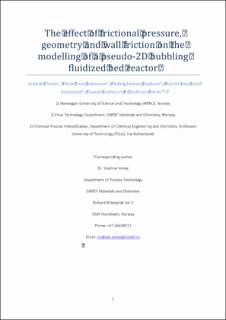| dc.contributor.author | Cloete, Schalk Willem Petrus | |
| dc.contributor.author | Johansen, Stein Tore | |
| dc.contributor.author | Zaabout, Abdelghafour | |
| dc.contributor.author | van Sint Annaland, Martin | |
| dc.contributor.author | Gallucci, Fausto | |
| dc.contributor.author | Amini, Shahriar | |
| dc.date.accessioned | 2020-12-14T11:10:07Z | |
| dc.date.available | 2020-12-14T11:10:07Z | |
| dc.date.created | 2015-07-23T09:33:52Z | |
| dc.date.issued | 2015 | |
| dc.identifier.citation | Powder Technology. 2015, 283 85-102. | en_US |
| dc.identifier.issn | 0032-5910 | |
| dc.identifier.uri | https://hdl.handle.net/11250/2719117 | |
| dc.description.abstract | The two fluid model (TFM) closed by the kinetic theory of granular flows (KTGF) has been developed to a high level of maturity over the past three decades. However, significant uncertainties still remain about the influence of various closure models on the predictions of the hydrodynamics and especially the reactive performance of fluidised bed reactors. The three factors investigated in this study – frictional pressure, geometry (2D/3D) and friction at the walls – all have significant influences on model predictions of the behaviour of a pseudo-2D bubbling fluidised bed reactor. This study aims to quantify the influence of these important factors on simulation output both in terms of hydrodynamics and reactive performance. Simulations designed to evaluate the effects of these factors were carried out over a wide range of fluidisation velocities, bed loadings and particle sizes to reveal significant impacts on the results. Differences in simulation results varied significantly with changes in the three operating variables investigated (fluidisation velocity, bed loading and particle size) and were analysed in detail. Finally, 3D simulations with wall friction and frictional pressure included showed qualitatively very similar hydrodynamic behaviour to that observed in the experiments. Quantitatively, measurements of the bed expansion ratio compared well for different fluidisation velocities and the particle sizes, but some unexplained differences were still observed in response to changes in the bed loading. | en_US |
| dc.language.iso | eng | en_US |
| dc.publisher | Elsevier | en_US |
| dc.rights | Attribution-NonCommercial-NoDerivatives 4.0 Internasjonal | * |
| dc.rights.uri | http://creativecommons.org/licenses/by-nc-nd/4.0/deed.no | * |
| dc.subject | Wall friction | en_US |
| dc.subject | Frictional pressure | en_US |
| dc.subject | Fluidised bed reactor | en_US |
| dc.subject | Two fluid model | en_US |
| dc.subject | Kinetic theory of granular flows | en_US |
| dc.title | The effect of frictional pressure, geometry and wall friction on the modelling of a pseudo-2D bubbling fluidised bed reactor | en_US |
| dc.type | Peer reviewed | en_US |
| dc.type | Journal article | en_US |
| dc.description.version | acceptedVersion | en_US |
| dc.rights.holder | © 2015. This is the authors’ accepted and refereed manuscript to the article. This manuscript version is made available under the CC-BY-NC-ND 4.0 license http://creativecommons.org/licenses/by-nc-nd/4.0/ | en_US |
| dc.source.pagenumber | 85-102 | en_US |
| dc.source.volume | 283 | en_US |
| dc.source.journal | Powder Technology | en_US |
| dc.identifier.doi | 10.1016/j.powtec.2015.04.060 | |
| dc.identifier.cristin | 1254948 | |
| dc.relation.project | Norges forskningsråd: 197580 | en_US |
| cristin.unitcode | 7401,80,5,2 | |
| cristin.unitname | Strømningsteknikk | |
| cristin.ispublished | true | |
| cristin.fulltext | postprint | |
| cristin.qualitycode | 1 | |

